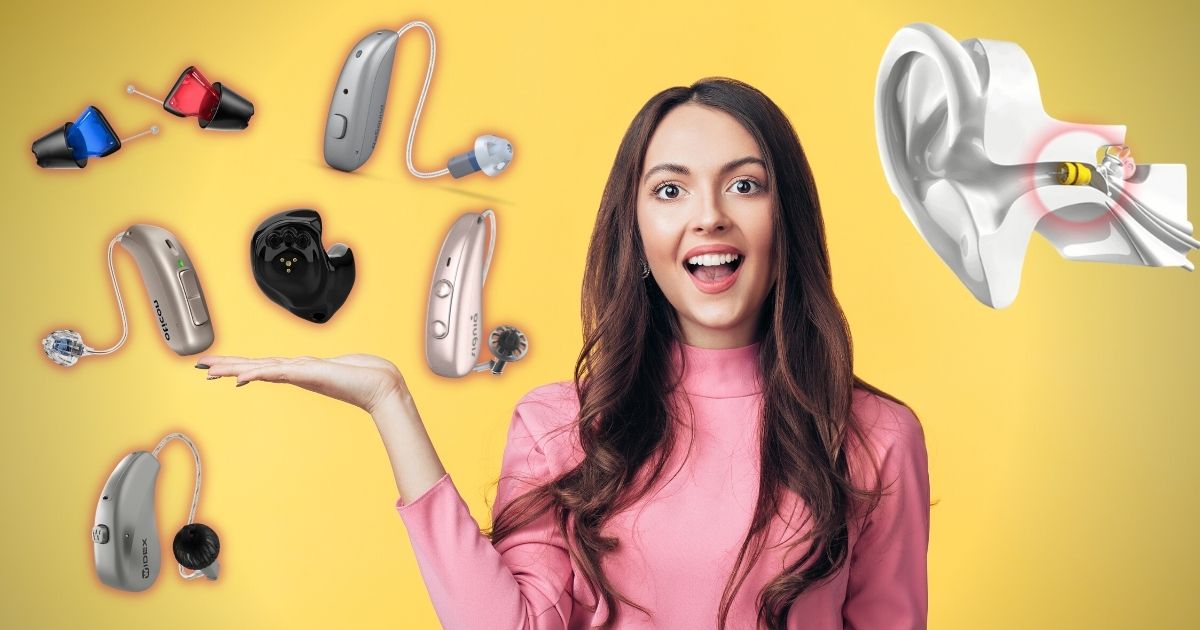Tinnitus, often described as the perception of sound without an external source, can manifest as ringing, roaring, or buzzing. Affecting an estimated 10 to 25% of adults, tinnitus is not a psychological condition. In some cases, it improves or disappears over time, but it can also become chronic when it persists for more than three months. Tinnitus is often associated with other conditions, primarily hearing loss, although it can result from various factors, including exposure to loud noises, certain medications, earwax buildup, infections, head or neck injuries, or even aging.
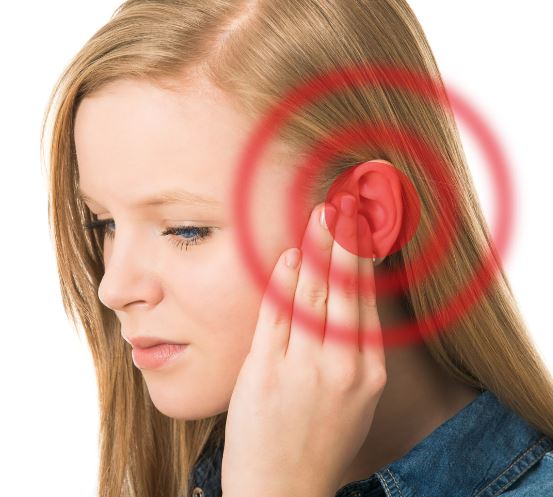 While tinnitus is rarely a serious medical problem, it can impact one’s mood, sleep, concentration, and, in severe cases, lead to anxiety or depression. Its impact on daily life varies from person to person. Some may choose to live with it if it’s not bothersome, while others find it severely hinders their daily activities.
While tinnitus is rarely a serious medical problem, it can impact one’s mood, sleep, concentration, and, in severe cases, lead to anxiety or depression. Its impact on daily life varies from person to person. Some may choose to live with it if it’s not bothersome, while others find it severely hinders their daily activities.
While there is currently no cure for chronic tinnitus, there are numerous treatment strategies that can help reduce its symptoms. These may include hearing aids, sound therapy, behavioral therapies like cognitive behavioral therapy (CBT), adjusting medications, or a number of other alternative treatments.
- Evaluation and treatment of tinnitus
- How do hearing aids help tinnitus?
- Emerging technologies for tinnitus
- Best hearing aids for tinnitus
- Can OTC hearing aids help tinnitus?
- Best hearing aid apps for tinnitus
Evaluation and Treatment of Tinnitus
The first step in treating tinnitus is a comprehensive audiological examination. Depending on the results, your hearing healthcare provider will make referrals tailored to the potential underlying causes.
To ensure a thorough evaluation of tinnitus, it’s important to start with a comprehensive audiology exam. This evaluation includes determining specific hearing thresholds for different pitches by testing the sound through headphones or inserts placed in the ear canal (air conduction) and through vibrations directed at the skull (bone conduction). This helps identify the type of hearing loss and includes word recognition testing.
Furthermore, additional assessments can be conducted to determine the pitch and loudness of the tinnitus, which can help tailor tinnitus management. These additional assessments are also usually performed by an audiologist.

If medical intervention is needed, a referral to an ENT or other specialist might be made. If hearing loss is the primary issue, your audiologist will generally recommend hearing aids along with auditory rehabilitation techniques designed to alleviate and manage tinnitus symptoms.
How Do Hearing Aids Help Alleviate Tinnitus?
Effective tinnitus management often involves a combination of hearing aids, aural rehabilitation, lifestyle adjustments, and (sometimes) medication changes customized to your specific symptoms and needs.
Modern hearing aids, apart from enhancing hearing, offer features designed for tinnitus relief. By amplifying background sounds, they make tinnitus less noticeable, aiding patients in adapting to the noise and reducing associated stress.
Additionally, they improve communication, further alleviating stress and anxiety.
Hearing aids alleviate tinnitus by:
- Restoring Environmental Sounds: They help wearers hear external noises that may be masked by tinnitus. This makes it easier to ignore internal sounds that can be distracting.
- Enhancing Emotional Well-being: Hearing aids may reduce feelings of depression and anxiety, ultimately improving one’s quality of life.
- Stimulating Auditory Pathways: They facilitate improved communication between the brain and the auditory system, which can help reduce tinnitus perception.
- Sound Therapy Programs: Many hearing aids offer external sounds, such as white noise or environmental sounds, to mask troublesome tinnitus sounds. This is particularly beneficial during tinnitus spikes.
- Clearer Speech: Hearing aids make speech clearer, reducing the effort required to understand conversations and enhancing concentration and communication.
- Background Sound: They generate a soft background noise that can help mask tinnitus, making it less noticeable.
- Tinnitus Relief Apps: Some models offer apps with relaxing tones, distracting sounds, and customizable programming to mask specific tinnitus frequencies. With compatible hearing aids, some smartphone models allow direct streaming of audio, which allows for the use of 3rd party apps in addition to the hearing aid app that might have some tinnitus features
- Stress Reduction: By reducing the effort needed to hear and understand sounds, especially speech, hearing aids help lower stress levels, which can alleviate tinnitus symptoms.
Emerging Technologies for Tinnitus Relief
In the ever-evolving landscape of hearing health, new technologies are continually being developed to offer more effective tinnitus management. Companies are pioneering innovative solutions through rigorous research and development.
Some of the latest developments include:
AI-Driven Algorithms
Artificial Intelligence (AI) and machine learning (ML) are not new concepts in hearing healthcare. Today’s sophisticated hearing aids, some with AI-driven algorithms, can adapt to different sound environments and even learn from user preferences. This allows for more personalized listening experience and can also mean enhanced tinnitus management and customization options.
Advanced Sound Masking
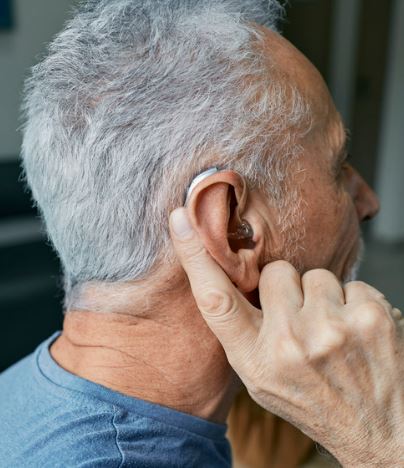 Sound masking technology has also seen significant advancements. The latest models offer a range of customizable masking sounds, such as fractal tones and sound layering, that can be adjusted in real-time.
Sound masking technology has also seen significant advancements. The latest models offer a range of customizable masking sounds, such as fractal tones and sound layering, that can be adjusted in real-time.
Widex has particularly excelled in this area for many years and currently offers highly customizable sound masking features with both fractal tones and nature sounds in its latest devices.
Real-Time Feedback
Some of the newest hearing aid models offer real-time feedback on the effectiveness of tinnitus management strategies, allowing for immediate adjustments. This feature is often coupled with data analytics to provide a comprehensive overview of your hearing health.
Remote Support Around the Clock
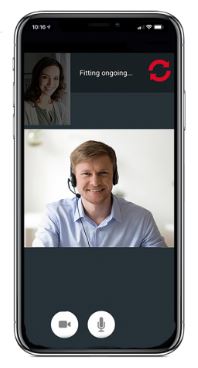 Many hearing aid companies are now offering remote support to their users through the use of AI-trained chatbots and consultations with audiologists to support users through the hearing aid adjustment period. In addition, these companies are also providing their users with resources available on their online platforms to help educate them and support their auditory journey. They are actively promoting patient-centered care where individuals take charge of their hearing health.
Many hearing aid companies are now offering remote support to their users through the use of AI-trained chatbots and consultations with audiologists to support users through the hearing aid adjustment period. In addition, these companies are also providing their users with resources available on their online platforms to help educate them and support their auditory journey. They are actively promoting patient-centered care where individuals take charge of their hearing health.
This latest technology represents a significant leap forward in tinnitus management, offering more personalized, adaptable, and accessible solutions for those experiencing tinnitus. As the field continues to evolve, users can look forward to even more innovative approaches to addressing this common hearing issue.
Not all hearing aids are the same when it comes to tinnitus relief. Choosing the right one involves considering various factors.
Bimodal Stimulation
While not related to specifically to hearing aid technology, one of the most promising advancements for tinnitus treatment in recent years is the concept of bimodal stimulation. This technology stimulates both the auditory system and another sensory system—often the sense of touch or even electrical stimulation of the tongue—to provide more comprehensive tinnitus relief.
A recent FDA-approved tinnitus treatment known as Lenire® has gained attention in this area. The device, created by Neuromod Devices and in use in Europe and now in the US, uses bimodal stimulation, simultaneously delivering tailored auditory tones through headphones and mild electrical pulses to the tongue via 32 electrodes to stimulate the trigeminal nerve. The idea behind Lenire® is to induce changes in the brain by stimulating both the trigeminal and auditory nerves, potentially reducing tinnitus symptoms.
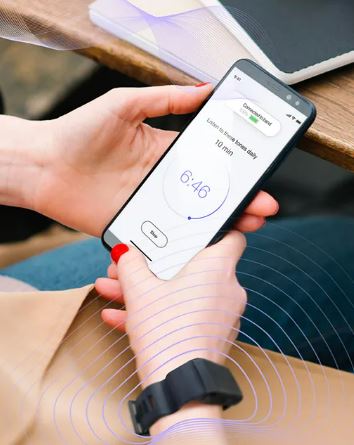 Using the same concept of bimodal stimulation, Neosensory Duo tinnitus program has also reported success with their wrist-worn device that pairs haptic vibration with auditory stimuli, including a recently published study in the International Tinnitus Journal that compared two groups: one listening to tones only, the other listening to tones with wristband vibrations. The latter group, experiencing both tones and vibrations, found significant relief, especially among those with severe tinnitus.
Using the same concept of bimodal stimulation, Neosensory Duo tinnitus program has also reported success with their wrist-worn device that pairs haptic vibration with auditory stimuli, including a recently published study in the International Tinnitus Journal that compared two groups: one listening to tones only, the other listening to tones with wristband vibrations. The latter group, experiencing both tones and vibrations, found significant relief, especially among those with severe tinnitus.
The Neosensory Duo tinnitus program includes a vibrating wristband responsive to environmental sound frequencies and a smartphone app playing various tones. Users pair the app with the wristband and follow a 10-minute daily routine of tone listening for two months.
Selecting the Right Hearing Aid for Tinnitus Relief
When selecting a hearing aid for tinnitus, it’s crucial to work with a qualified audiologist and consider your overall hearing abilities and goals. Effective hearing aids for tinnitus work by addressing sounds within a similar frequency range as your hearing loss.
Many of the latest prescription model of hearing aids can not only address address a person’s unique hearing loss, but they often also allow for access to a variety of therapeutic sounds to help manage tinnitus symptoms.
Best Hearing Aids for Tinnitus
Here are the top recommended hearing aids for tinnitus relief, along with their respective pros and cons:
ReSound Nexia
 The ReSound Nexia hearing aid family features both non-rechargeable and rechargeable models, with the compact microRIE as the smallest and most advanced. ReSound Nexia offers improved speech understanding in noisy environments through a 4-microphone binaural beamformer, omnidirectional listening, and Bluetooth® LE Audio for multiple connections and hands-free calls. Notably, it is compatible with Auracast™ broadcast audio, allowing users to receive announcements and share audio.
The ReSound Nexia hearing aid family features both non-rechargeable and rechargeable models, with the compact microRIE as the smallest and most advanced. ReSound Nexia offers improved speech understanding in noisy environments through a 4-microphone binaural beamformer, omnidirectional listening, and Bluetooth® LE Audio for multiple connections and hands-free calls. Notably, it is compatible with Auracast™ broadcast audio, allowing users to receive announcements and share audio.
The new microRIE model is 25% smaller than standard models and offers access to various tinnitus masking sounds through its popular user-friendly Smart 3D app.
Pros:
- Excellent sound quality and clarity.
- Easy smartphone integration for control and adjustments.
- Among the most extensive sound therapy options and adjustments for tinnitus relief.
Cons:
- Premium pricing (not currently available in entry level technology)
- No in-ear models are yet available for those who don’t want an over-ear device
Oticon Real
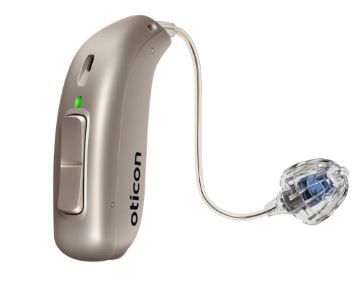 The Oticon Real is an advanced hearing aid that prioritizes improving clarity and reducing the impact of disruptive sounds. It includes an on-board Deep Neural Network (DNN), trained with 12 million real-life sound scenes. This DNN makes sounds more distinct and works seamlessly across varying listening environments. Oticon devices also offer Tinnitus SoundSupport to allow users to take control of their tinnitus by playing a wide range of relief sounds like white noise and soothing ocean-like sounds. Users can control the sounds in their aids using the company’s companion app.
The Oticon Real is an advanced hearing aid that prioritizes improving clarity and reducing the impact of disruptive sounds. It includes an on-board Deep Neural Network (DNN), trained with 12 million real-life sound scenes. This DNN makes sounds more distinct and works seamlessly across varying listening environments. Oticon devices also offer Tinnitus SoundSupport to allow users to take control of their tinnitus by playing a wide range of relief sounds like white noise and soothing ocean-like sounds. Users can control the sounds in their aids using the company’s companion app.
Pros:
- Advanced technology for sound processing.
- Wide range of tinnitus relief features.
- Customizable settings for personalized hearing experience.
Cons:
- Premium pricing (not currently available in entry level technology)
- No in-ear models are yet available for those who don’t want an over-ear device
Phonak Audéo Lumity
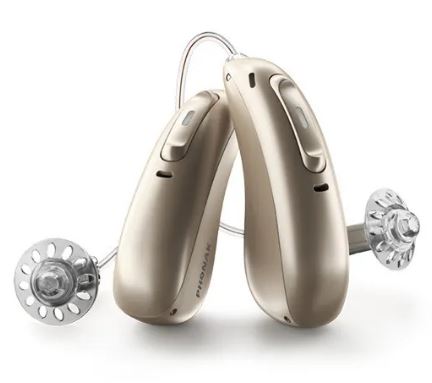 The Phonak Audéo Lumity consists of rechargeable models are available in different technology tiers (90, 70, 50, and 30). The devices incorporate advanced features like SpeechSensor and StereoZoom 2.0 to enhance speech clarity in various listening environments. These devices offer Bluetooth connectivity for streaming audio from various devices and can pair with up to 8 devices simultaneously. They feature motion sensors and tap control for hands-free phone calls and other functions. The Audéo Lumity is also compatible with accessories like the Roger remote microphone, offering enhanced listening options for users. It offers tinnitus balance noise generators and programmable features through the myPhonak app.
The Phonak Audéo Lumity consists of rechargeable models are available in different technology tiers (90, 70, 50, and 30). The devices incorporate advanced features like SpeechSensor and StereoZoom 2.0 to enhance speech clarity in various listening environments. These devices offer Bluetooth connectivity for streaming audio from various devices and can pair with up to 8 devices simultaneously. They feature motion sensors and tap control for hands-free phone calls and other functions. The Audéo Lumity is also compatible with accessories like the Roger remote microphone, offering enhanced listening options for users. It offers tinnitus balance noise generators and programmable features through the myPhonak app.
Pros:
- High-quality sound and speech clarity
- Universal connectivity for great phone compatibility
- Available in wider range of technologies (entry level to premium)
Cons:
- Only rechargeable models available
- No in-ear styles are yet available for those who don’t want an over-ear device
Widex MOMENT Sheer
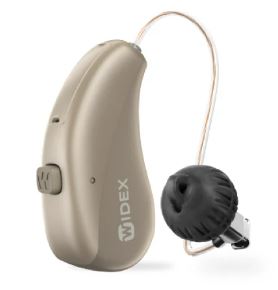 Widex provides hearing aids available in various models and technology levels and has long catered to users with tinnitus. With its latest line, MOMENT Sheer, standing out for its exceptional sound processing speed, processing sound in just 0.5 milliseconds, providing a more authentic listening experience. MOMENT Sheer features MySound 2.0, an AI-based customization tool that combines artificial intelligence with wearer intent to offer personalized sound experiences, and it introduces Widex SoundRelax, an expanded library of fractal sounds for soothing wearers with and without tinnitus.
Widex provides hearing aids available in various models and technology levels and has long catered to users with tinnitus. With its latest line, MOMENT Sheer, standing out for its exceptional sound processing speed, processing sound in just 0.5 milliseconds, providing a more authentic listening experience. MOMENT Sheer features MySound 2.0, an AI-based customization tool that combines artificial intelligence with wearer intent to offer personalized sound experiences, and it introduces Widex SoundRelax, an expanded library of fractal sounds for soothing wearers with and without tinnitus.
Pros:
- Super fast processing and AI-base customization
- Effective sound masking for tinnitus with expanded library of options
- Multiple style and technology levels to fit user preferences
Cons:
- Can be on the expensive side.
- May be more advanced than needed for some individuals.
Starkey Genesis AI
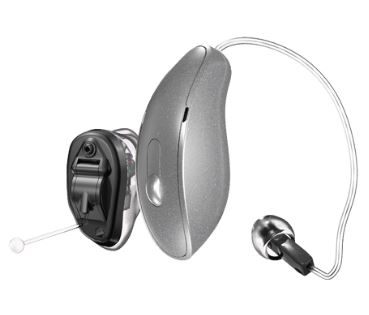 Starkey’s Genesis AI technology claims to be the industry’s most advanced processor technology, a rechargeable battery that offers 51 hours of usage on a single charge, and the smallest rechargeable receiver-in-canal (RIC) with sensor. A new 2.4 GHz completely-in-canal (CIC) hearing aid, powered by the Starkey Neuro Processor and Neuro Sound Technology, has also been introduced.
Starkey’s Genesis AI technology claims to be the industry’s most advanced processor technology, a rechargeable battery that offers 51 hours of usage on a single charge, and the smallest rechargeable receiver-in-canal (RIC) with sensor. A new 2.4 GHz completely-in-canal (CIC) hearing aid, powered by the Starkey Neuro Processor and Neuro Sound Technology, has also been introduced.
The Genesis AI hearing aid lineup also includes a redesigned standard case for greater user convenience and a 25% increase in battery life. Moreover, the Neuro Processor, with increased speed and transistors, mimics the central auditory system’s function. It features enhancements to Edge Mode+ and various professional and patient updates. The devices offer multiflex tinnitus technology sound therapy features, accessible in the app.
Pros:
- Cutting-edge AI technology for real-time adjustments.
- Available in both RIC and in-ear styles, including rechargeable custom devices
- Multiflex Tinnitus Technology creates a comforting and customizable sound stimulus
Cons:
- Premium pricing
- Advanced features may not be necessary for all users.
Signia Pure and Silk IX Charge&Go
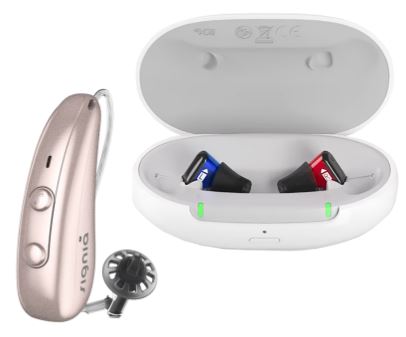 Signia’s Integrated Xperience (IX) hearing aid platform, including the Pure Charge&Go IX and Silk Charge&Go IX, is the first to track multiple conversation partners in real-time, improving speech clarity in multi-speaker environments. The RealTime Conversation Enhancement solution offers significant speech understanding enhancements and personalized support through AI-powered Signia Assistant. Pure Charge&Go IX is receiver-in-canal with own voice comfort technology, while Silk Charge&Go IX is a rechargeable, completely-in-the-canal (CIC) hearing aid.
Signia’s Integrated Xperience (IX) hearing aid platform, including the Pure Charge&Go IX and Silk Charge&Go IX, is the first to track multiple conversation partners in real-time, improving speech clarity in multi-speaker environments. The RealTime Conversation Enhancement solution offers significant speech understanding enhancements and personalized support through AI-powered Signia Assistant. Pure Charge&Go IX is receiver-in-canal with own voice comfort technology, while Silk Charge&Go IX is a rechargeable, completely-in-the-canal (CIC) hearing aid.
Like previous models, the IX platform offers tinnitus masking features with various sounds. Since 2017, Signia has offered its proprietary Tinnitus Notch Therapy, which works by determining the pitch of the tinnitus sound and then creating a spectral notch that matches that pitch in hopes it will allow the brain to gradually ignore the tinnitus sound over time.
Pros:
- Notch therapy for specific tinnitus frequency reduction.
- Enhanced speech clarity
- Offers both over-ear and in-ear options
Cons:
- Silk devices don’t have Bluetooth, so some features are more limited
- IX platform devices are only available as rechargeable at this time
Phonak Lyric
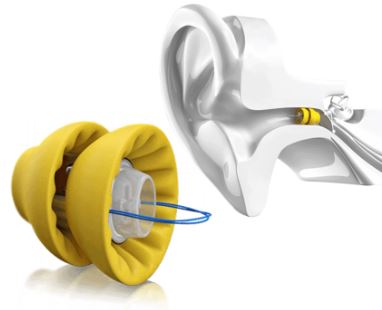 Phonak Lyric offers a unique hearing aid solution designed for uninterrupted living, as it remains completely invisible in the ear canal and can be worn 24/7 for months. Unlike traditional hearing aids that process sound outside the ear, Lyric uses the ear’s natural anatomy to provide a full, natural listening experience. The device is placed deep in the ear canal near the eardrum by a professional, requiring no daily maintenance, battery changes, or charging. Lyric offers tinnitus relief and improved sleep quality, with surveys indicating that it can reduce tinnitus annoyance faster than daily wear hearing aids.
Phonak Lyric offers a unique hearing aid solution designed for uninterrupted living, as it remains completely invisible in the ear canal and can be worn 24/7 for months. Unlike traditional hearing aids that process sound outside the ear, Lyric uses the ear’s natural anatomy to provide a full, natural listening experience. The device is placed deep in the ear canal near the eardrum by a professional, requiring no daily maintenance, battery changes, or charging. Lyric offers tinnitus relief and improved sleep quality, with surveys indicating that it can reduce tinnitus annoyance faster than daily wear hearing aids.
Available through authorized Lyric Providers on a subscription basis, Lyric users can enjoy new devices regularly with the added convenience of SoundLync, a magnetic adjustment tool. Additionally, Lyric can be used with any type of phone and headphones simultaneously, making it a discreet and hassle-free hearing solution highly recommended by users.
Pros:
- Invisible design for discreet use and no daily maintenance required
- Continuous wear for tinnitus relief day and night.
- Effective tinnitus management.
Cons:
- Limited availability of providers and fitting options
- Requires regular replacement and ongoing subscription
- Premium pricing, typically more than traditional hearing aids
Each of these brands offers unique features designed to provide tinnitus relief, with varying pros and cons. The best choice depends on your specific needs, lifestyle, and budget. Consult a hearing healthcare provider for a personalized treatment plan, which may include one of these hearing aids for tinnitus relief.
OTC Hearing Aids – for Tinnitus?
While over the counter (OTC) hearing aids are not intended or designed for treating tinnitus and are specifically for those with mild to moderate hearing loss, for reasons outlined above, hearing aids are often effective at reducing the annoying symptoms of tinnitus.
If you’ve already had a professional evaluation and were advised to use hearing aids but are looking for a more budget-friendly solution, over-the-counter (OTC) hearing aids could be a suitable choice. Notably, OTC devices equipped with Bluetooth audio streaming can provide wearers the option to stream audio from third-party tinnitus apps that may have been suggested by their hearing care provider.

Some notable OTC self-fit options include:
- Sennheiser All-Day Clear Hearing Aids: The Sennheiser All-Day Clear OTC hearing aids offer easy-to-follow setup, in-the-moment controls, audio/music streaming, personalized reminders, and guidance. Both models, the All-Day Clear and All-Day Clear Slim, are priced at $1,399.95 and $1,499.95, respectively, and come with a 45-day risk-free trial.
- Sony CRE-C10 and CRE-E10 Hearing Aids: Developed in partnership with WS Audiology, these self-fitting OTC hearing aids are user-friendly and customizable through the Sony | Hearing Control App. The CRE-C10 is available for $999.99, while the CRE-E10 is available for $1,299.99, offering noise reduction, directionality, audio streaming with iPhone, and adaptability to changing environments for an enhanced listening experience.
- The HP Hearing PRO self-fitting OTC hearing aids resemble earbuds and offer improvement in speech understanding in noisy environments, and Active Noise Cancellation. They are currently priced at $499.00 for a pair with a rechargeable case, audio streaming capability and users can personalize their hearing profiles through the HP Hearing app.
-
Lexie Lexie B2 Hearing Aids, Powered by Bose, featuring a fully rechargeable battery providing up to 18 hours of battery life from a 3-hour charge time. These receiver-in-canal hearing aids come with a self-tuning system that pairs with the Lexie app, allowing wearers to customize their devices, adjust treble and bass frequencies, and switch between various environmental settings, available for $999/pair or 24 monthly payments of $49 per month.
- Jabra Enhance Select 50R offers access to a dedicated Audiology Team for personalized follow-up care, including adjustments and video chats, while providing medical-grade technology with Bluetooth streaming and lightweight comfort. It is custom-programmable to individual hearing needs and comes with an easy-to-use app for control, all at a more affordable price, and includes a long-lasting rechargeable battery with up to 30 hours of use on a single charge. Available currently online at Best Buy for $1195/pair.
- Lucid Hearing Engage Rechargeable OTC hearing aids, available for $799.99/pair, offer an affordable and comfortable solution for individuals with mild to moderate hearing loss, available through various retailers. These devices come with a variety of accessories and features, including Bluetooth streaming, dynamic directional microphones, noise reduction, and moisture resistance.
There are a number of OTC devices available today, in a wide range of prices, along with many more poised to come onto the market throughout 2024.
Best Hearing Aid Apps for Tinnitus:
While there are many good tinnitus apps available, many of today’s advanced hearing aids come with companion apps that allow for customizing sounds and also tinnitus features. Additionally, some hearing aid companies make tinnitus apps for general use, which are not for a specific model of hearing device. Some apps allow for minimal level of adjustment of the tinnitus sounds or features, while others allow users to modify and customize the tinnitus masker’s intensity, pitch, and settings for a more personalized experience.
Notable hearing aid apps with tinnitus features include the ReSound Smart 3D app, Oticon ON app, and Starkey Thrive/My Starkey apps, as well as the newly updated Signia app.

Below we highlight a few of the most popular apps:
- Widex Zen. The program includes a timer for the tinnitus masker and the convenient feature of adjusting volume separately for the left and right ear. The Widex Zen app provides a sound player with soothing Zen sounds, designed for adults seeking a relaxing background to manage tinnitus. These sounds can be used as part of a tinnitus treatment program prescribed by a licensed hearing healthcare professional. The app also offers educational tools to enhance tinnitus awareness and coping strategies. The app can be used with or without hearing aid amplification, depending on the user’s preferences and needs. Available for iOS and Android.
- Starkey Relax is an app designed as an informational resource and self-management tool, intended for use in a hearing professional’s sound therapy protocol for individuals diagnosed with tinnitus. The app allows users to personalize 12 relief sounds by adjusting volume, frequency response, and fluctuation rate to create highly customized relief sounds tailored to their specific tinnitus. Users can also pair these sounds with soothing images to address the evolving nature of their tinnitus. Available for iOS and Android.
- ReSound Smart 3D and Relief apps. Resound offers two valuable apps: the ReSound Smart 3D app for controlling hearing aids, with some control over onboard tinnitus features (if activated by your professional) and the ReSound Relief app for tinnitus management. The Smart 3D app allows users to customize their hearing aid settings, including volume control, program changes, and sound preferences, as well as assisting in locating misplaced hearing aids. The Relief app provides options for tinnitus masking using various sounds. Both apps can be paired with hearing aids and offer additional features like remote programming and troubleshooting guidance. Available for iOS and Android.
- Oticon Companion is a versatile app that offers discreet control and personalization of your Oticon Bluetooth hearing aids. It allows you to adjust volume, switch between listening programs, monitor battery levels, and find lost hearing aids. The app also features a range of relief sounds for tinnitus control, including white noise and soothing ocean-like sounds. Additionally, it offers compatibility for remote support and adjustments from your hearing care professional via live video calls. Available for iOS and Android.
Summary
Tinnitus is a common condition often associated with hearing loss, and hearing aids can significantly reduce its impact. The hearing aids listed offer various tinnitus-minimizing strategies at range of different price points. It is essential to consult with a hearing healthcare professional to decide the best solution for your individual needs.
They can best help you determine if a prescription hearing aid is required or if an over-the-counter (OTC) hearing aid or tinnitus relief app could provide enough tinnitus management to meet your specific needs.
Hearing Aid Resources:
- Oticon hearing aids
- Jabra hearing aids
- Starkey hearing aids
- Phonak hearing aids
- Sennheiser hearing aids
- HP Hearing Aids
- ReSound hearing aids
- Sony hearing aids
- Widex hearing aids
- Lexie hearing aids
- Lucid hearing aids
References:
- Workman, B. (2023) Understanding Tinnitus: What Causes it and How Can it be Treated? Hearing Health & Technology Matters.
- Del Bo L, Ambrosetti U. Hearing aids for the treatment of tinnitus. Prog Brain Res. 2007;166:341-5. doi: 10.1016/S0079-6123(07)66032-4. PMID: 17956798.
- American Tinnitus Association (2023). Hearing Aids / Masking Devices. https://www.ata.org/about-tinnitus/therapy-and-treatment-options/hearing-aids-masking-devices/
- Medical News Today. (2023). Do hearing aids help with tinnitus? https://www.medicalnewstoday.com/articles/hearing-aids-for-tinnitus#Summary
About the author
 Nausheen Dawood is an experienced Audiologist and Project Manager with a professional background including primary health care, corporate social investment, and business development. Proficient in the development of academic courses, training, and lecturing, with a focus on clinical student training and supervision. Adept in freelance copywriting, particularly in audiology and health-related topics. Holds a Masters degree in Audiology (Cum Laude), with a strong foundation in clinical research, project development, and strategic planning, complemented by technical training. Specializes in content development and training tailored to diverse audiences. Demonstrates a long-term commitment to research and development, including the implementation of randomized controlled trials, projects, and clinical examinations. Known for establishing robust networks and cultivating valuable stakeholder relationships.
Nausheen Dawood is an experienced Audiologist and Project Manager with a professional background including primary health care, corporate social investment, and business development. Proficient in the development of academic courses, training, and lecturing, with a focus on clinical student training and supervision. Adept in freelance copywriting, particularly in audiology and health-related topics. Holds a Masters degree in Audiology (Cum Laude), with a strong foundation in clinical research, project development, and strategic planning, complemented by technical training. Specializes in content development and training tailored to diverse audiences. Demonstrates a long-term commitment to research and development, including the implementation of randomized controlled trials, projects, and clinical examinations. Known for establishing robust networks and cultivating valuable stakeholder relationships.



